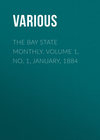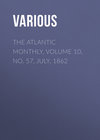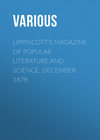Kitabı oku: «Birds and Nature, Vol. 12 No. 2 [July 1902]», sayfa 5
The gems known as moonstone and sunstone owe the play of colors which gives them their respective names to similar causes. These gems are generally some form of Feldspar, although any mineral giving a similar sheen of color might be included under them. The moonstone of commerce comes chiefly from Ceylon, where it occurs in large pieces the size of a fist in a clay resulting from the decomposition of a porphyritic rock. Pieces of these when polished exhibit the beautiful pale blue light coming from within which makes the stone prized as a gem. The cause of this light is undoubtedly minute tabular crystals lying in parallel position through the stone.
The stone varies from translucent to opaque, and from colorless to white, the essential feature being the blue opalescent light or chatoyancy exhibited from a polished surface. Good moonstones are worth from three to five dollars a carat.
The Ceylon moonstone is sometimes known as Ceylon opal, but it is the variety of Feldspar known as orthoclase, which is a potash Feldspar, differing from the microcline just described in being monoclinic in crystallization and in having two cleavages meeting at right angles. Another species of Feldspar used as moonstone is albite. This is a soda Feldspar and is triclinic, but exhibits the color characteristic of moonstone. One variety is known as peristerite, from the Greek word for pigeon, and is applied on account of the resemblance of the sheen to that of a pigeon’s neck. It is found at Macomb, St. Lawrence county, New York. Albite found at Mineral Hill, Pennsylvania, also exhibits the chatoyancy of moonstone. Amelia Court House, Virginia, is another locality whence come pieces either of orthoclase or oligoclase exhibiting this property. Like most of the more or less opaque gems, moonstone is cut chiefly in the rounded form known as en cabochon. It is of late, however, cut in the form of balls, which are quite popular, the bringing of good luck being attributed to them. The brilliancy of moonstone is considerably increased by mounting it against black.
Sunstone is the term by which those kinds of Feldspar are known which reflect a spangled yellow light. The appearance comes from minute crystals of iron oxide, hematite or gothite, which are included in the stone and both reflect the light and give it a reddish color. Like labradorite the sheen is visible only when the stone is held at a certain angle. Some specimens of the mineral carnallite, which is a chloride of potassium and magnesium, exhibit a similar sheen, and being soluble in water the crystals of hematite can be separated out. They are then seen to be perfect little hexagons of a blood-red color. The sheen of sunstone is best visible when the stone is held in the sunlight or strong artificial light. The variety of Feldspar to which the sunstone most in use at the present time belongs is oligoclase, a soda-lime triclinic Feldspar. Like labradorite it usually exhibits on the surface of easiest cleavage parallel striations due to twinning structure. The best sunstone at the present time comes from Tvedestrand, in southern Norway, where it occurs in compact masses together with white quartz, in veins, in gneiss. Some also comes from Hittero, Norway. In Werchne Udinsk, Siberia, another occurrence was discovered in 1831. Previous to this Bauer states that all the sunstone known came from the Island of Sattel in the White Sea, and was very costly, although of a quality which would not now be deemed desirable. At the present time, although stones of fine quality can be obtained, sunstone is little used in jewelry, and its market value is very low. Statesville, North Carolina, and Delaware county, Pennsylvania, are two localities in the United States where good sunstone has been obtained.
Both sunstone and moonstone can be accurately imitated in glass and the distinction of the artificial from the real by ocular examination alone would be almost impossible. Glass, however, lacks the cleavage of Feldspar and is somewhat heavier and softer. The discovery of the method of making artificial sunstone is said to have been accidental, and was made at Murano, near Venice, when a quantity of brass filings by chance fell into a pot of melted glass. The product was for a long time and is still used in the arts under the name of goldstone. Sunstone is sometimes known as aventurine Feldspar, in distinction from aventurine quartz, which presents a similar appearance, owing to the inclusion of scales of mica. The term aventurine is from the Italian avventura, meaning chance, and refers to the chance discovery above referred to.
Gems are occasionally cut from other forms of Feldspar than those here described, which are transparent and colorless and valued for their lustre. The varieties chiefly employed in this manner are adularia, a variety of orthoclase which is often transparent, the best specimens being obtained in Switzerland, and oligoclase, in the transparent form in which it is found near Bakersville, North Carolina.
Oliver Cummings Farrington.
THE WOOD HARMONY
Who knows the dim, least-traveled way
Where wood-folk keep their holiday;
Who knows the paths of little care
Whereon the thicket-dwellers fare,
Let him be heedful, lest he wake
Unfriendly echoes in the brake,
Or dare, with alien thought, to find
His way among the timid kind.
Let him beware, then, for they know
The subtle footsteps of a foe.
But all the wee wood-fellows spare
Such welcome as they ever share
To him who finds in dale and dell
That undefined, familiar spell
That greets the faith prepared to meet
A faith as beautiful and sweet.
– Frank Walcott Hutt.
THE COTTAGE BY THE WOOD
It was my good fortune to spend some months in a cozy little cottage in a suburban district, the natural surroundings of which were such as to at once appeal to a naturalist, aside from furnishing ample opportunity for rest and quiet. The large lawn belonging to the property, with its abundance of shade trees, fronted on the main avenue of a populous corporate town, while in the rear was a strip of woodland, which in turn was bordered by a clearing covered mainly by briars and thick low bushes, its whole length being intersected by a winding brook.
Birds in the locality were quite numerous and some of them showed remarkable tameness. During the hours of night time, giving voice as it were to the weird lights and shadows around the house, we could hear the mournful ditty of a screech owl whose home was in a nearby hickory tree, while the first gray streak of each returning dawn was heralded by the sweet songs of the robins. Flickers were frequently seen hopping around in the grass near the roots of various trees; the notes of the yellow-billed cuckoo were also heard in the thick foliage of the maples: redeyed vireos kept up a continual warbling all day long and doubtless had a nest in the vicinity, as we observed the mother bird feeding two very young ones; the latter being perched in a low bush in the yard. The happy song of the house wrens was always in evidence and three nests were built under the porch roof. I personally observed one of the broods leaving the nest and was surprised to see two of their number climb up the straight trunk of a wild cherry tree – genuine woodpecker fashion – for a distance of twelve or fifteen feet, where the limbs began to branch out. However, they arrived at the top safely and remained there for the balance of the day.
Humming birds often came and hovered over the many beautiful flowers in the yard, and sometimes consented to alight for a few minutes for our benefit. On one of these occasions a party of five (including my baby daughter) approached to within three feet of the flower stalk upon which our little visitor was perched; still it sat there, turning its wee head this way and that, looking at us with fearless unconcern. At last it gave a sharp chirp, flew, and was soon lost to sight. On one occasion in the early morning, we were greeted with the familiar call “Bob White,” which seemed to come from the woods in the rear of the yard. The call was repeated several times, but we were unable to discover the author of it. A tree of fine red cherries proved a great attraction for cat birds and other feathered fruit lovers. But what we considered the greatest privilege, and one which was exceedingly enjoyed, was the daily greeting of the wood thrushes during the breakfast hour. What could be more charming than to sit leisurely eating the morning meal and all the while listening to the sweet, clear strains of the loveliest bird songs pouring from the throats of the russet-brown vocalists just outside the kitchen window, peal after peal, in endless volume and variation. In addition to the birds already mentioned we sometimes heard the shrill scream of the blue jay, also the notes of the king birds and crested flycatchers, while from the distance, floating to us from across some field or meadow, came the morning praises of a meadow lark or the well known call of the kildeer. The crows also added their deep caw-caw-caw to the chorus of woodland voices. The clearing above referred to proved to be the home of two or three species of the warbler family, and a walk through the vicinity the following winter revealed a number of nests. They were all placed low, and one of them showed every indication of having been built and occupied by an oven bird.
The usual wild flowers of the season were abundant and the surrounding country at large was admirably suited for exploration and research; hence our sojourn at the “Cottage” was one of great pleasure and instruction.
Berton Mercer.
A NEW ARGYNNIS
The butterfly to which I want to introduce you is a rare beauty! It is called Argynnis nitocris nigrocaerulea by scientists, but the young people of our school call it the blue-black silver spot or the Sapello Fritillary. They wanted very much to name it after the Territory, but unfortunately there is a butterfly of this genus that bears the name of New Mexico Silver-spot.
Every member of the genus Argynnis is beautiful and it is a great treat to see the glint of the silver dotted wings of these butterflies as they hover about the gaily colored flowers in some mountain canyon or alpine meadow. But no member of the genus will compare in beauty with the female of the nigrocaerulea, and I should find difficulty in forgetting the pleasure I felt in seeing two of these lovely creatures sucking the nectar from a large bright colored Rudbeckia.
The nigrocaerulea is very much like a silver-spot that is found in the mountains of Arizona; both belong to the species nitocris and there is still a third form found in the mountains of Mexico. It is very likely that these forms were the same years ago, but the mountains in this arid region are like islands, and are separated by dry expanses upon which an Argynnis could not live. It follows, therefore, that in the isolated mountain regions many forms of the same species may be found, and when the country has been more carefully explored we shall very probably find other varieties of nitocris.
The nigrocaerulea was discovered in August, 1900, in the Sapello Canyon, a beautiful canyon in the Rocky Mountains near Las Vegas, New Mexico. The male is reddish-fulvous on the upper surface, with well defined markings consisting of waved transverse lines and crescent shaped spots. On the under side the design of the fore wings is somewhat indistinctly repeated, and the base is colored with a most exquisite reddish pink. The under surface of the hind wings is a rich brown with a wide yellow border, and is profusely marked with spots of glistening silver. The female on the upper side is bluish black, well marked near the margin by large spots of yellow suffused with blue. The under surface is very like that of the male, though the colors are more pronounced, the brown in the hind wing merging into black. The Sapello Fritillary flies during the month of August. Though the caterpillar is not known, it is supposed to feed upon the leaves of violets, which grow very abundantly in the Sapello Canyon. Diligent search will be made for it, and I am sure all will be interested if at some future time I can give the history and picture of the chrysalis of this beautiful Silver-spot.
Wilmatte Porter Cockerell.
Lo, the bright train their radiant wings unfold!
With silver fringed, and freckled o’er with gold:
On the gay bosom of some fragrant flower
They, idly fluttering, live their little hour;
Their life all pleasure, and their task all play,
All spring their age, and sunshine all their day.
– Mrs. Barbauld.
![Birds and Nature, Vol. 12 No. 2 [July 1902]](https://cdn.litres.ru/pub/c/cover_100/25569223.jpg)









